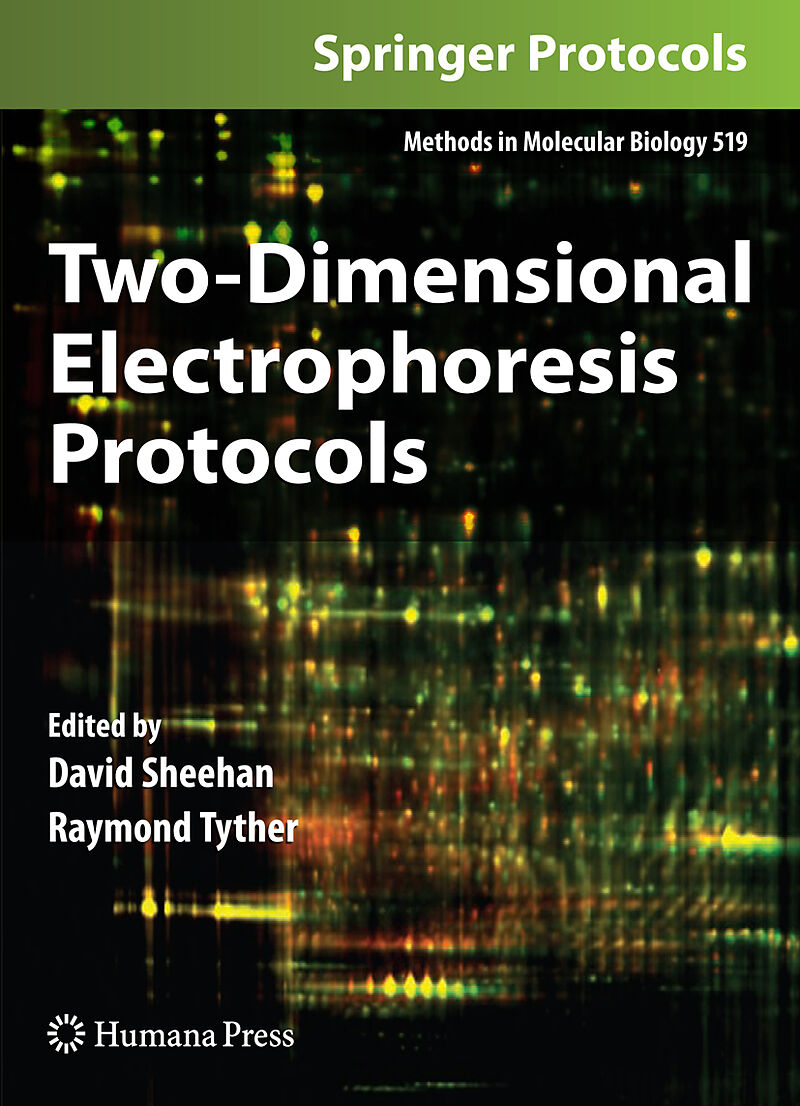Two-Dimensional Electrophoresis Protocols
Einband:
Fester Einband
EAN:
9781588299376
Untertitel:
Methods in Molecular Biology 519
Genre:
Biologie
Herausgeber:
Humana Press Inc.
Auflage:
2009 edition
Anzahl Seiten:
546
Erscheinungsdatum:
2009
ISBN:
978-1-58829-937-6
In this book, expert researchers examine cutting edge-proteomics methodologies, explore their application to biological materials, and look at how these developments have helped standardize the design, execution, and analysis of proteomics experiments.
The human genome and other large-scale genome sequencing projects have inevitably led to a focus on the proteins encoded by genes. The field of proteomics has grown enormously as a result and a number of high-throughput technologies have now been developed allowing discovery-led investigations of protein populations rather than more traditional hypothesis-led studies on single proteins. These high-throughput techno- gies include gene and protein microarrays, the yeast two-hybrid system, and various mass spectrometry methodologies. However, despite developments and improvements in these technologies, two-dimensional electrophoresis (2DE) remains one of the most widely used approaches. This technique was revolutionised by the development of immobilised pH gradient strips which are now commercially available. This has made possible highly reproducible separations of matched samples. Developments in staining, mass spectr- etry, and bioinformatics supported these developments and have led to a measure of standardisation in design, execution, and analysis of proteomics experiments. This book began life as a proposed update of the excellent volume 2DE Protocols edited by Andrew Link of the University of Washington at Seattle. However, we re- ised that 2DE has undergone major development in aspects of its technology in recent years and we were anxious to reflect these in the present volume. We are also conscious that many researchers have now begun to apply proteomics methodologies to a growing range of biological material and we were anxious to include contributions to reflect the challenges posed in sample preparation in less widely used organisms.
Covers a wide biological range of proteome sources including microbes, plants and animals Addresses key aspects of experimental design Includes some of the latest approaches such as DIGE and detection of post-translational modification Includes supplementary material: sn.pub/extras
Klappentext
Two-dimensional electrophoresis (2-DE) remains one of the most popular techniques for proteomic comparisons. Revolutionized by the development of immobilized pH gradient strips, this vital process has benefited greatly from recent developments in staining, mass spectrometry, and bioinformatics. In Two-Dimensional Electrophoresis Protocols, expert researchers examine these cutting edge proteomics methodologies, explore their application to a wide range of biological materials, and look at how these developments have helped standardize the design, execution, and analysis of proteomics experiments. Chapters reflect key steps in 2-DE experiments, including sample preparation, staining, post-translational modification, spot identification, and bioinformatics. Composed in the highly successful Methods in Molecular Biology series format, each chapter contains a brief introduction, step-by-step methods, a list of necessary materials, and a Notes section which shares tips on troubleshooting and avoiding known pitfalls. Innovative and reader-friendly, Two-Dimensional Electrophoresis Protocols encourages newcomers to apply powerful 2-DE techniques to their own research, while also providing current and essential information for seasoned scientists.
Inhalt
TWO-DIMENSIONAL ELECTROPHORESIS PROTOCOLS David Sheehan and Raymond Tyther (Editors) Proteomics Research Group Dept. Biochemistry University College Cork Ireland Contents Preface Contributors Overview Chapters 1. Two-Dimensional Electrophoresis (2-DE): An Overview Richard Smith 2. Solubilisation of Proteins in 2-DE: An Outline Thierry Rabilloud 3. Selection of pH Ranges in 2-DE Mirielle Starita-Geribaldi 4. Difficult Proteins Ben Herbert and Elizabeth Harry 5. Organelle Proteomics Matthias Plöscher, Bernhard Granvogl, Veronika Reisinger, Axel Masanek and Lutz Eichacker 6. Applications of Chemical Tagging Approaches in Combination With 2-DE and Mass Spectrometry Alexander Leitner and Wolfgang Lindner 7. Immunoblotting 2-DE Membranes Brian McDonagh Protocols Chapters 8. Troubleshooting Image Analysis in 2-DE Bettina Levänen and Asa Wheelock 9. Analysis of Bacterial Proteins by 2-DE Philip Cash and Evelyn Argo 10. Proteomic Analysis of Caenorhabditis elegans Pan-Young Jeong, Keun Na, Mi-Jeong Jeong, David J. Chitwood, Yhong-Hee Shim and Young-Ki Paik 11. Protein Extraction for 2-DE Claus Zabel and Joachin Klose 12. Analysis of Proteins from Marine Molluscs. Suze Chora, Maria Bebianno and Michele Romeo 13. Preparation and Analysis of Plant and Plastid Proteomes by 2-DE. Anne von Zychlinski and Wilhelm Gruissem 14. High-Resolution2-DE Katrin Marcus, Cornelia Joppich, Caroline May, Kathy Pfeiffer, Barbara Sitek, Helmut E. Meyer, and Kai Stuehler 15. Blue Native Gel Electrophoresis (BN-PAGE) Proteomics Kelly Adringa, Adrienne King and Shannon Bailey 16. 2DE for Proteome Analysis of Human Metaphase Chromosomes Kiichi Fukui and Susumu Uchiyama 17. Microsomal Proteomics Diana Wong and Khosrow Adeli 18. Pre-Fractionation Using Microscale Solution IEF Won-A Joo and David Speicher 19. Diagonal Electrophoresis for Detection of Protein Disulphide Bridges Brian McDonagh 20. High-Resolution Large Gel 2-DE Claus Zabel and Joachim Klose 21. Silver-Staining of Proteins in 2-DE Gels Cécile Lelong, Mireille Chevallet, Sylvie Luche, Thierry Rabilloud 22. Detection of 4-Hydroxy-2-Nonenal and 3-Nitrotyrosine-Modified ProteinsUsing a Proteomics Approach Rukhsana Sultana, Tanea Reed and Allan Butterfield 23. Proteomic Detection of Oxidized and Reduced Thiol Proteins in Cultured Cells Sarah Cuddihy, James Baty, Kristin Brown, Christine Winterbourn and Mark Hampton 24. Detection of Ubiquitination in 2DE Brian McDonagh 25. Phosphoproteome Analysis by in-Gel Isoelectric Focusing and Tandem Mass Spectrometry Sarka Beranova-Giorgianni, Dominic Desiderio, Francesco Giorgianni 26. Detection of Protein Glutathionylation Elizabetta Gianazza, Ivano Eberini and Pietro Ghezzi 27. Activity-Based Protein Profiling of Protein Tyrosine Phosphatases Chad Walls, Bo Zhou, and Zhong-Yin Zhang 28. Active Protease Mapping in 2-DE Gels Zhenjun Zhao and Pamela Russell 29. Two-Dimensional Difference Gel Electrophoresis Gert Van den Bergh 30. Protein Expression

Leider konnten wir für diesen Artikel keine Preise ermitteln ...
billigbuch.ch sucht jetzt für Sie die besten Angebote ...
Die aktuellen Verkaufspreise von 6 Onlineshops werden in Realtime abgefragt.
Sie können das gewünschte Produkt anschliessend direkt beim Anbieter Ihrer Wahl bestellen.
Loading...
Die aktuellen Verkaufspreise von 6 Onlineshops werden in Realtime abgefragt.
Sie können das gewünschte Produkt anschliessend direkt beim Anbieter Ihrer Wahl bestellen.
| # | Onlineshop | Preis CHF | Versand CHF | Total CHF | ||
|---|---|---|---|---|---|---|
| 1 | Seller | 0.00 | 0.00 | 0.00 |
